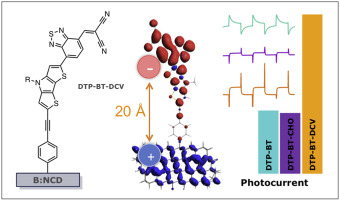Electrochimica Acta ( IF 5.5 ) Pub Date : 2020-01-23 , DOI: 10.1016/j.electacta.2020.135762 J. Raymakers , A. Artemenko , F. Verstraeten , H. Krysova , J. Cermák , S.S. Nicley , D. Lopez-Carballeira , A. Kromka , K. Haenen , L. Kavan , W. Maes , B. Rezek

|
Encouraged by its rich surface chemistry and excellent electrochemical properties, boron-doped nanocrystalline diamond (B:NCD) is a promising p-type photoelectrode in dye-sensitized solar cells. One method of diamond surface functionalization using stable carbon-carbon bonds involves the electrochemical grafting of diazonium salts. However, this method typically leads to multilayers that may complicate the transport of photogenerated charges. Here, we establish functionalization of B:NCD electrodes by a monolayer of ethynylphenyl molecules using sterically hindered 4-(trimethylsilyl)ethynylbenzenediazonium tetrafluoroborate. Both the density and structural orientation of the grafted layer are investigated by angular resolved X-ray photoelectron spectroscopy, confirming the presence of covalently grafted monolayers. After removal of the trimethylsilyl protective groups, the resulting ethynyl functionalities are employed to immobilize organic donor-acceptor chromophores via Sonogashira cross-coupling reactions. Homogenous surface coverage is achieved even on the B:NCD electrode. Atomic scale DFT computing reveals that for the chromophore with the strongest acceptor unit, efficient charge separation of 20 Å is obtained where photogenerated holes move directly into diamond. Yet, photocurrent and photovoltage measurements suggest competitive electron recombination to the diamond electrode via the redox electrolyte. Correlation between the density of the molecular layer and photocurrents/photovoltage provides better understanding of the charge generation and recombination pathways in diamond-organic photoelectrochemical cells.
中文翻译:

具有共价连接的生色团单层的金刚石电极上的光生电荷收集
受其丰富的表面化学和出色的电化学性能的鼓舞,掺硼纳米晶金刚石(B:NCD)是染料敏化太阳能电池中一种有前途的p型光电极。使用稳定的碳-碳键的金刚石表面功能化的一种方法涉及重氮盐的电化学接枝。但是,该方法通常导致多层,这可能会使光生电荷的传输复杂化。在这里,我们通过使用空间受阻的4-(三甲基甲硅烷基)乙炔基苯重氮四氟硼酸酯通过乙炔基苯基分子的单层建立B:NCD电极的功能化。通过角分辨X射线光电子能谱研究了接枝层的密度和结构取向,证实了共价接枝单层的存在。除去三甲基甲硅烷基保护基团后,所得乙炔基官能团用于通过Sonogashira交叉偶联反应固定有机供体-受体生色团。即使在B:NCD电极上也可以实现均匀的表面覆盖。原子尺度DFT计算表明,对于具有最强受体单元的发色团,在光生空穴直接移入金刚石的情况下,可获得20Å的有效电荷分离。然而,光电流和光电压的测量表明竞争性电子通过氧化还原电解质重新结合到金刚石电极上。分子层的密度与光电流/光电压之间的相关性提供了对金刚石有机光电化学电池中电荷产生和重组途径的更好理解。所得乙炔基官能团用于通过Sonogashira交叉偶联反应固定有机供体-受体生色团。即使在B:NCD电极上也可以实现均匀的表面覆盖。原子尺度DFT计算表明,对于具有最强受体单元的发色团,在光生空穴直接移入金刚石的情况下,可获得20Å的有效电荷分离。然而,光电流和光电压的测量表明竞争性电子通过氧化还原电解质复合到金刚石电极上。分子层的密度与光电流/光电压之间的相关性提供了对金刚石有机光电化学电池中电荷产生和重组途径的更好理解。所得乙炔基官能团用于通过Sonogashira交叉偶联反应固定有机供体-受体生色团。即使在B:NCD电极上也可以实现均匀的表面覆盖。原子尺度DFT计算表明,对于具有最强受体单元的发色团,在光生空穴直接移入金刚石的情况下,可获得20Å的有效电荷分离。然而,光电流和光电压的测量表明竞争性电子通过氧化还原电解质重新结合到金刚石电极上。分子层的密度与光电流/光电压之间的相关性提供了对金刚石有机光电化学电池中电荷产生和重组途径的更好理解。











































 京公网安备 11010802027423号
京公网安备 11010802027423号